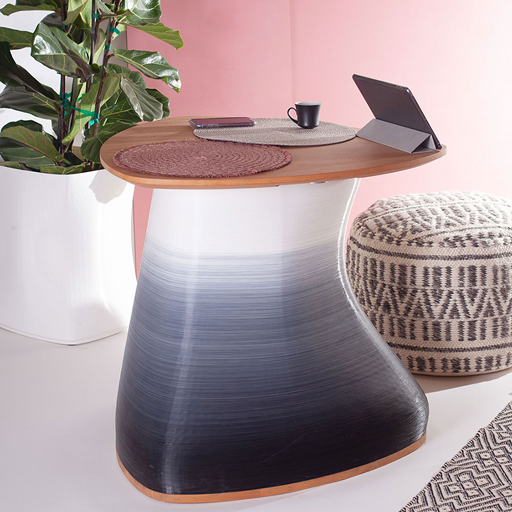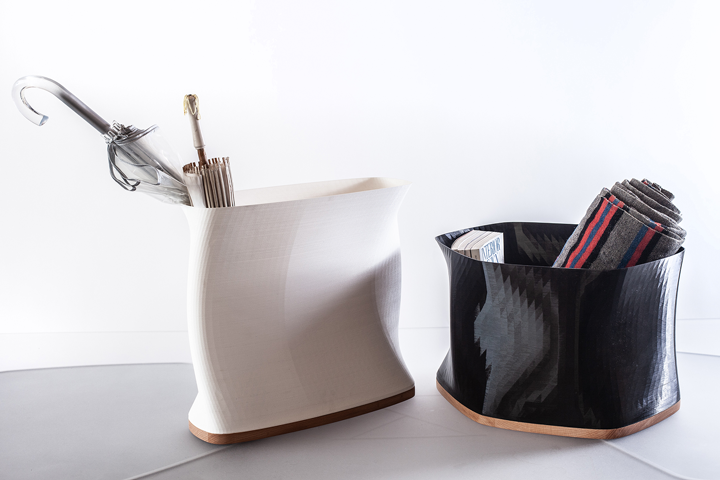We've had to produce our own printers in-house to address the speed issue, and can now produce a coffee table in just a few hours. What it really impacts is how production scales, and what sort of products we can offer our customers.
 Sustainable 3D Printed Furniture Allows for Infinite Customizations
Sustainable 3D Printed Furniture Allows for Infinite Customizations

Jeffrey McGrew | Model No. Furniture
Please tell us about Model No. and your background with 3D printing.
Model No. is the world's first customizable quick-ship designer 3D printed furniture company. Our goal is to offer great furniture and accessories that the customers can customize themselves to fit their needs perfectly, with short lead times and reasonable prices. Before Model No. we'd all done some small scale 3D printing, but never large-scale 3D printing, and with no one else really doing what we needed we had to develop that ability in-house.
What does Sustainable Furniture Making entail? How does that mesh with 3D-printed furniture?
Sustainable furniture depends on four things, first are the materials going into the production sustainably produced? Second, just how far do the materials or the product have to travel in fulfilling an order? Third, will people love the product enough to keep it for a long time, and lastly is there a plan for when it's no longer needed?

3D printing helps us meet all of these goals. It lets us easily use materials derived from food waste or non-petroleum origins instead of typical plastics and foams. It lets us locally produce the products with significantly less shipping distances of both materials and finished goods due to not needing huge centralized factories with a location primarily based upon labor costs. It helps us make products that are exactly what our customers want, where they can customize it suit their needs perfectly. And once the product isn't needed anymore, we can take it back and recycle most of it back into materials we can use to produce more products.
What sorts of materials are specific to 3D-printed furniture, whether they be new or traditional?
It's not so much materials, but more in the delivery of the materials as part of the printing process. Furniture is large with rather forgiving tolerances, where it's also ok for something to have a more interesting and vibrant texture. So we don't have to aim to produce parts that look and feel exactly the same as an injected-molded part, for example, but instead need to make something interesting yet durable. Also by combining CNC routed wood and aluminum elements into our products we can bring a 'traditional' note to the aesthetics, so it looks and feels more like furniture than just a large 3D printed object.
3D printing is a notoriously slow process. How long does it take to print, say, a coffee table? What does the 3D-printing process entail when it comes to furniture making?
We've had to produce our own printers in-house to address the speed issue, and can now produce a coffee table in just a few hours. What it really impacts is how production scales, and what sort of products we can offer our customers. For example, custom furniture traditionally is very expensive and has long lead times. But with 3D printing, customization is almost free. It doesn't take us longer to produce a coffee table in one size or shape versus another, so once the parametric product design and website is in place we can offer our customers customizable products for standard prices and short delivery times.

Can you tell us about the working relationship amongst your team? I know that Model No. eschews strict furniture designer and manufacturer roles in favor of architects, engineers, web developers and specialty fabricators collaborating. Talk us through that.
We're trying to build a new type of furniture company, and that requires inventing and rethinking many things along the way. For example, if we're to empower people to make it easy and fun to design your own furniture, then the approach to designing the products, how you sell the products, and then how you make the products is so different from what the traditional industry is doing that we can't really look to it for answers. A typical furniture designer can't make parametric products, that automatically 'flex' so that they can be customized yet still look and work great. A normal furniture catalog or website can't sell those products effectively, so that customers can really see what it's going to look like before they buy it. And a normal factory optimized around mass production / distribution can't produce something where every product can be different. So we've had to build our own design, web, and production team, and invent the automation and software platforms that enable us to do this.
How important is 3D Scanning to Model No. Furniture's future, and the industry at large?
We currently aren't making use of 3D scanning, although we are exploring the use of Augmented Reality as a sales tool to help people find what furniture fits into their spaces best.
What's next for Model No. Furniture? And for the greater furniture industry?
Model No. is going to be launching many new products over the next few months. It's a very exciting time for both us and the 3D printing industry, as more companies focus on large-format printing in new materials! And we think furniture in general is going to continue moving towards more customization, more sustainable, and more interesting products overall.
If you like this article you may like "Quick Guide to Metal Additive Manufacturing for Industrial Components"
The content & opinions in this article are the author’s and do not necessarily represent the views of ManufacturingTomorrow
Comments (0)
This post does not have any comments. Be the first to leave a comment below.
Featured Product


